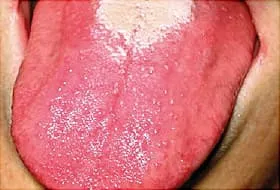Strawberry tongue is a symptom of different medical conditions. Your tongue can look like the skin of a strawberry — swollen, red, and bumpy. Strawberry tongue can result from an allergic condition, a vitamin deficiency, or an infection.
Strawberry tongue usually appears bright red but can also start out white. The color depends on the condition causing it.
What Are the Symptoms of Strawberry Tongue?
Strawberry tongue mainly changes how your tongue looks. Normally, your tongue is pink with tiny bumps. With strawberry tongue, your tongue can turn bright red. And the bumps become larger to look like the seeds on the outside of a strawberry.
It’s sometimes called raspberry tongue because the bumps also look like raspberry seeds. Strawberry tongue usually appears with other symptoms.
“If [strawberry tongue] occurs, you will also have a lot of other symptoms — like a sore throat,” says Sarah Fitzpatrick, DDS, a clinical assistant professor of oral pathology at the University of Florida, Gainesville, FL. “The tongue is usually a more minimal problem at that point.”
Strawberry tongue vs. glossitis
Glossitis happens when your tongue gets inflamed, swollen, and red. An allergic reaction, infection, or dry mouth can cause glossitis. This condition also changes how your tongue looks. So, glossitis is sometimes mistaken for strawberry tongue.
But glossitis can make your tongue look smooth or glossy, instead of bumpy. And glossitis may also cause raised areas on the middle or back of your tongue. But unlike strawberry tongue, it doesn’t cause a bumpy texture.
Both glossitis and strawberry tongue are symptoms of different conditions. But glossitis is most likely caused by a condition not related to strawberry tongue.
What Causes Strawberry Tongue?

Strawberry tongue can be a symptom of the following:
Kawasaki disease. This condition mostly affects children under the age of 5. It can cause inflammation in your arteries. These blood vessels carry blood throughout your body. Kawasaki disease can especially impact the vessels around your heart.
You can also have a high fever, rash, and peeling skin, usually near your nails. And you may have swollen lymph nodes in your neck as well as red, goopy eyes. If it’s not treated, Kawasaki disease can damage your blood vessels.
Scarlet fever. The same bacteria that cause strep throat can sometimes lead to scarlet fever. It’s most common in children aged 5-15. The bacteria can release a toxin, causing a red, sandpaper-like rash across most of your body.
You can also get red lines in the folds of your skin. And you may have red spots on the roof of your mouth, a high fever, and a sore throat. With scarlet fever, your tongue may start out white and bumpy and turn bright red later.
Food or drug allergies.In rare cases, strawberry tongue may be a sign of allergies. You may be allergic to a medicine you’ve taken or something you’ve eaten. But glossitis is the more common reaction to allergies, not strawberry tongue.
Toxic shock syndrome (TSS). TSS is a rare but life-threatening side effect of certain bacterial infections. Most cases are linked to tampon use. But it can also happen from a wound, scrape, burn, or putting gauze inside your nose to stop bleeding (nasal packing).
With TSS, you can also get a sunburn-like rash, red eyes or throat, or a sudden high fever. You may also have nausea, vomiting, or diarrhea. And sometimes, you can get other flu-like symptoms appearing quickly, over 48 hours. The syndrome can get worse fast. So, it’s important to see a doctor immediately if you think you have it.
Vitamin B12 and folate (B9) deficiency. Vitamin B12 and folate help your body make red blood cells and DNA. They also keep your nerves and blood cells healthy. Your body can’t make these vitamins on its own. So, you must eat enough foods rich in vitamin B12 and folate. A deficiency in these vitamins can lead to physical, neurological, and psychological problems. While rare, B12 or folate deficiency can sometimes cause strawberry tongue.
Yellow fever. Mosquitoes spread viral infections like yellow fever. Although mostly in parts of Africa and South America, it usually causes flu-like symptoms. But in serious cases, the fever can lead to organ failure. While it’s extremely uncommon, strawberry tongue can sometimes show up with yellow fever. Getting vaccinated can help lower your risk of getting yellow fever.
Multisystem inflammatory syndrome (MIS-C). This rare but serious condition is a reaction to COVID-19 (SARS-CoV-2). The virus causes inflammation in different parts of your body. Your heart, lungs, kidneys, and brain can become inflamed. It happens more often in children — even with mild or no COVID symptoms. In a small number of cases, children with MIS-C also had strawberry tongue.
Strawberry tongue "always warrants a visit to your doctor," says Vineet Dhar, BDS, MDS, PhD, a board-certified pediatric dentist, clinical professor, and chair of Orthodontics and Pediatric Dentistry at the University of Maryland School of Dentistry in Baltimore, MD.
When to see your doctor
You should see your doctor if you have:
- Fever
- Rash
- Trouble swallowing
- A general feeling of being unwell
“In children, [these symptoms] should be assessed promptly, as [they] may indicate Kawasaki disease,” says Dhar. “[Kawasaki disease] requires immediate treatment to prevent heart complications.”
How Is Strawberry Tongue Treated?
Most of the conditions causing strawberry tongue are treatable. The best treatment depends on your symptoms and diagnosis.
Here are some possible treatments your doctor may suggest:
Antibiotics. With bacterial infections, such as scarlet fever or toxic shock syndrome, your doctor may prescribe antibiotics. You should start to feel better within a few days.
Antihistamines. If allergies are causing strawberry tongue, your doctor can give you antihistamines. The medicine may help lower swelling and redness.
IV immunoglobulin (IVIG). For Kawasaki disease, doctors usually treat children with IVIG, a medication made from human antibodies. The medicine can help boost their immune system.
Supplements. If you have a B12 or folate deficiency, your doctor may suggest a vitamin supplement. You can also eat more foods rich in those vitamins. B12-rich foods include tuna, salmon, and oysters. Foods containing folate include spinach, kale, and beets.
To ease discomfort from strawberry tongue, you can:
- Stay well-hydrated with cool fluids.
- Avoid spicy, citrus, or acidic foods that might irritate your tongue.
- Maintain good oral hygiene with gentle brushing.
- Soothe your tongue with popsicles or ice cream.
Anytime your tongue turns red, it usually means the top layer of tissue has become thinner. Your tongue may be more sensitive.
“There are over-the-counter and prescription pain relief options, but these should never take the place of a doctor’s visit,” says Fitzpatrick.
Can You Prevent Strawberry Tongue?
It depends on what causes your strawberry tongue. With allergies, avoid your triggers and take antihistamines to lower your chances for strawberry tongue. If you get periods, make sure to change your tampon often. This can lower your risk for toxic shock syndrome. Or consider using sanitary pads instead.
If you travel to an area with yellow fever, get vaccinated. This can protect you from an infection. Although there's no vaccine to prevent scarlet fever, good hygiene habits can help. Wash your hands often. Cover your mouth and nose when you cough or sneeze.
Eat a more balanced diet with meat, dairy, and eggs. Be sure to eat leafy green vegetables to get enough B12 and folate. Although you can’t prevent Kawasaki disease, you can spot the signs early. This can help you better manage and treat the condition.
Takeaways
Strawberry tongue appears as a bright red, bumpy tongue that looks like a strawberry. It’s not a medical condition, but a symptom of an infection, allergies, or even a vitamin deficiency. If you notice any changes in how your tongue looks, talk to your doctor about the cause. Your doctor can check you for Kawasaki disease and treat any infection, allergy, or vitamin deficiency.
Strawberry Tongue FAQs
Is strawberry tongue contagious?
Strawberry tongue isn’t contagious. It’s only a symptom. But some of the illnesses causing strawberry tongue are contagious. Scarlet fever and Yellow fever are contagious.
Is strawberry tongue dangerous?
Strawberry tongue isn’t dangerous on its own; it’s just a symptom. But if you don’t treat some of the conditions causing it, it can become serious. If you have strawberry tongue, make sure to talk to your doctor. They can help you treat your allergies, infection, or vitamin deficiency. They can also treat Kawasaki disease.
Does strawberry tongue go away?
Yes. The symptom of strawberry tongue goes away after you treat the medical condition causing it. Once your doctor finds and treats the allergy, infection, or vitamin deficiency, it will go away.
Can you have strawberry tongue without strep?
Yes, you can have strawberry tongue without strep. Strep infection is only one cause for strawberry tongue. Allergies, other types of infection, and vitamin deficiency can cause it, too.




